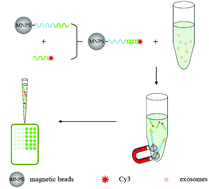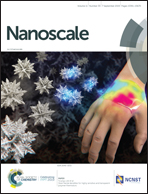An aptamer-based new method for competitive fluorescence detection of exosomes
Abstract
Exosomes have been recognized as promising sources of biomarkers for early cancer diagnosis due to their important role in the occurrence and metastasis of cancer, and so the development of a sensitive low-cost detection method for exosomes is highly desirable. In this paper, we report a fluorescence method for the competitive detection of exosomes based on an aptamer specific to CD63 (an exosome transmembrane protein). Aptamer-modified magnetic beads were hybridized with a Cy3-labeled short sequence complementary to a region of the aptamer. In the presence of exosomes, the CD63 on the exosomes bound to the aptamer, resulting in the shedding of the short sequence into the supernatant. The quantity of the exosomes could be estimated by detecting the fluorescence intensity in the supernatant. This method could detect exosomes at a concentration as low as 1.0 × 105 particles per μL under optimal conditions, and the feasibility of the method for exosome detection in complex clinical samples was also proved using simulated serum samples. The detection cost and difficulty are significantly reduced compared to conventional methods, while ensuring sensitivity, and so this method provides a basis for subsequent exosome detection in specific cancer cells.



 Please wait while we load your content...
Please wait while we load your content...